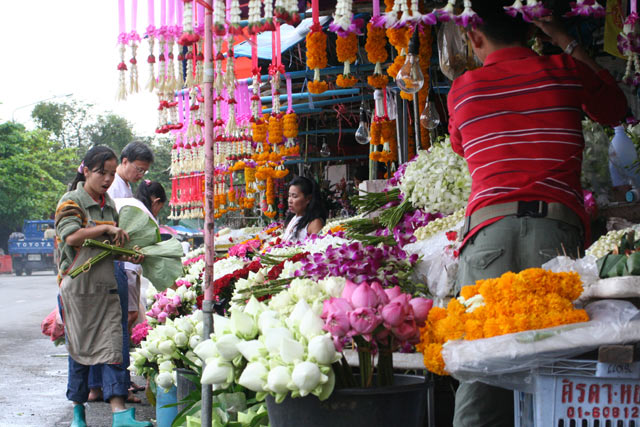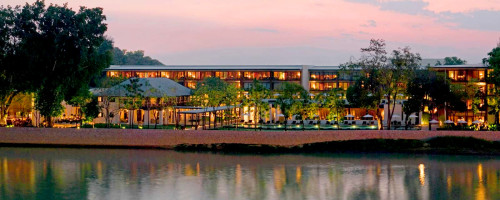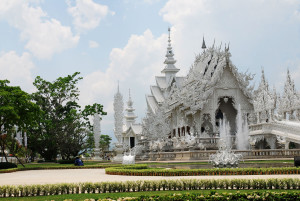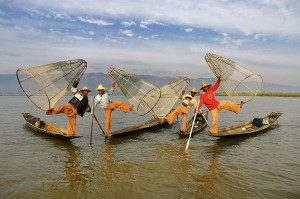Thailand’s northern capital, Chiang Mai, is a beguiling place. It’s the most important city in the north, but the pace of life is slow and easy. Clean, but never sterile, its streets are easy to navigate, yet filled with tucked-away treasures.
Sanuk (sa-nook) is a Thai term, meaning to enjoy oneself and to derive pleasure and joy from something. Here is our short guide to sanuk in Chiang Mai…
What to do?
Chiang Mai’s four-and-a-half centuries as capital of the Lanna Kingdom (1292-1775) have left the city with an extensive collection of wats. While you can happily spend a day or two here going from wat to wat, we recommend you save your energy for the following:
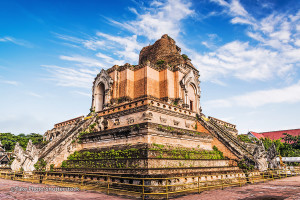 Impressive Wat Chedi Luang once stood 84m tall, until the top part of its chedi was toppled by an earthquake in 1545 – nevertheless, its 60m-tall ruins remained the tallest structure in Chiang Mai until well into the twentieth-century.
Impressive Wat Chedi Luang once stood 84m tall, until the top part of its chedi was toppled by an earthquake in 1545 – nevertheless, its 60m-tall ruins remained the tallest structure in Chiang Mai until well into the twentieth-century.
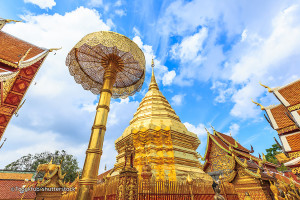 Mountain top Wat Phra That Doi Suthep is one of Chiang Mai’s most famous landmarks, built on the slopes of Doi Suthep after a white elephant selected this spot to house a holy relic. Climb the 300 steps to the wat (or take the lift), admire the view and ring the wat’s impressive collection of bells and gongs.
Mountain top Wat Phra That Doi Suthep is one of Chiang Mai’s most famous landmarks, built on the slopes of Doi Suthep after a white elephant selected this spot to house a holy relic. Climb the 300 steps to the wat (or take the lift), admire the view and ring the wat’s impressive collection of bells and gongs.
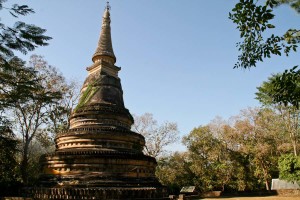 Atmospheric Wat U Mong Thera Jan was built for a “mad” monk in the 14th century, then practically abandoned until 1948 when a handful of lay people restored the ancient forest-girt chedi and cleared out the networks of caves and passageways that sit beneath it.
Atmospheric Wat U Mong Thera Jan was built for a “mad” monk in the 14th century, then practically abandoned until 1948 when a handful of lay people restored the ancient forest-girt chedi and cleared out the networks of caves and passageways that sit beneath it.
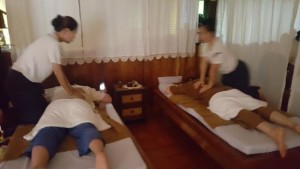 After all that wat-hopping, it may well be time for a massage, either in the plush surroundings of your hotel spa, or in the more off-beat Vocational Training Centre of the Chiang Mai Women’s Correctional Institution, where inmates (all non-violent offenders) participating in the prison’s job-training program will soothe any aching muscles with an excellent (and very reasonably priced) massage.
After all that wat-hopping, it may well be time for a massage, either in the plush surroundings of your hotel spa, or in the more off-beat Vocational Training Centre of the Chiang Mai Women’s Correctional Institution, where inmates (all non-violent offenders) participating in the prison’s job-training program will soothe any aching muscles with an excellent (and very reasonably priced) massage.
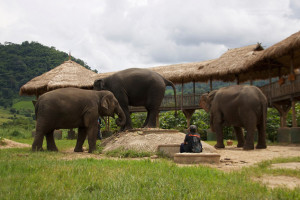 For a day trip out of Chiang Mai, one of the most worthwhile is a day at the Elephant Nature Park an elephant rescue and rehabilitation centre about 60km from Chiang Mai. The centre has effectively set the gold-standard for pampering pachyderms, many of whom are recovering from abuse in the name of the tourist trade elsewhere in Thailand.
For a day trip out of Chiang Mai, one of the most worthwhile is a day at the Elephant Nature Park an elephant rescue and rehabilitation centre about 60km from Chiang Mai. The centre has effectively set the gold-standard for pampering pachyderms, many of whom are recovering from abuse in the name of the tourist trade elsewhere in Thailand.
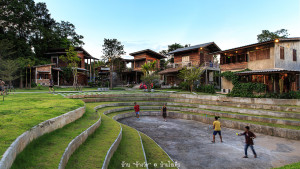 For something closer to the city, trip out to Baan Kang Wat a peaceful artistic community housed in a pretty, purpose-built village on the way to Doi Suthep. Browse the galleries (all the artisans live and work on-site), walk through the gardens and stop for multiple cups of excellent coffee as you go.
For something closer to the city, trip out to Baan Kang Wat a peaceful artistic community housed in a pretty, purpose-built village on the way to Doi Suthep. Browse the galleries (all the artisans live and work on-site), walk through the gardens and stop for multiple cups of excellent coffee as you go.
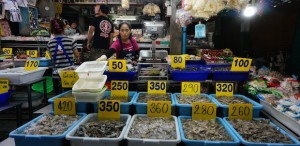 Finally, leave time to explore Chiang Mai’s markets. Talat Muang Mai is the city’s wholesale food market, at its best in the early morning, when you can see huge cargoes of beautiful tropical fruit – Malay apples, durians, rambutans, mangoes – being unloaded from barges and sold on to fruit stalls around the city.
Finally, leave time to explore Chiang Mai’s markets. Talat Muang Mai is the city’s wholesale food market, at its best in the early morning, when you can see huge cargoes of beautiful tropical fruit – Malay apples, durians, rambutans, mangoes – being unloaded from barges and sold on to fruit stalls around the city.
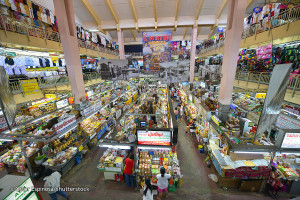 Talat Warorot is the city’s oldest market, and a great place to pick up everyday Thai household items (sticky rice steamers, tiny statues for spirit houses), and Chiang Mai’s flower market, Talat Ton Lam Yai, is immediately adjacent.
Talat Warorot is the city’s oldest market, and a great place to pick up everyday Thai household items (sticky rice steamers, tiny statues for spirit houses), and Chiang Mai’s flower market, Talat Ton Lam Yai, is immediately adjacent.
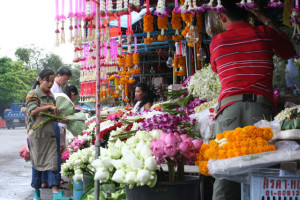 If you’re in Chiang Mai over a weekend, then you can enjoy three weekly markets: Ban Haw’s Friday Market is the most interesting of the three, bringing together Muslim, Shan and hilltribe vendors and shoppers; on Saturday, Thanon Wualai’s Saturday Walking Street is the place to head for souvenirs, many with an arty twist; come Sunday, Thanon Ratchdamnoen turns into the Sunday Walking Street, with food vendors taking over wat courtyards (and many of the same vendors as the Saturday market).
If you’re in Chiang Mai over a weekend, then you can enjoy three weekly markets: Ban Haw’s Friday Market is the most interesting of the three, bringing together Muslim, Shan and hilltribe vendors and shoppers; on Saturday, Thanon Wualai’s Saturday Walking Street is the place to head for souvenirs, many with an arty twist; come Sunday, Thanon Ratchdamnoen turns into the Sunday Walking Street, with food vendors taking over wat courtyards (and many of the same vendors as the Saturday market).
What to eat?
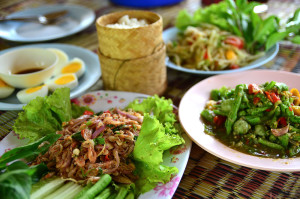 Without coconut milk, palm sugar or fish sauce, Chiang Mai’s native Isaan cuisine has few of the hallmarks of Thai food as you know it. In their place are herbs, roots and other unusual plants found in the north’s jungles. Food here is pork-and vegetable-driven and, while still spicy, it is not as hot as the food in southern Thailand. Isaan’s palette of flavours incorporates and moves beyond the familiar Thai balance of hot-sour-salty-sweet, to touch on the less familiar territory of bitter and pungent.
Without coconut milk, palm sugar or fish sauce, Chiang Mai’s native Isaan cuisine has few of the hallmarks of Thai food as you know it. In their place are herbs, roots and other unusual plants found in the north’s jungles. Food here is pork-and vegetable-driven and, while still spicy, it is not as hot as the food in southern Thailand. Isaan’s palette of flavours incorporates and moves beyond the familiar Thai balance of hot-sour-salty-sweet, to touch on the less familiar territory of bitter and pungent.
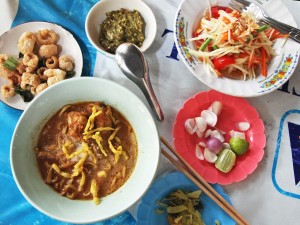 A bowl of khao soi makes an easy and tasty introduction to Isaan’s cuisine. Wheat noodles are served in a thin curry sauce, topped with a drizzle of coconut milk and a handful of crunchy deep-fried noodles. At the table, the diner adds pickles, sliced shallots and lime juice to taste. Once you’ve finished your first bowl, it’s easy to see why khao soi is one of Chiang Mai’s most famous culinary exports. As chef Andy Ricker puts it, “It’s exotic without being weird and, most important, completely delicious.” The dish also bears the stamp of Chiang Mai’s location, incorporating influences from nearby China and Burma.
A bowl of khao soi makes an easy and tasty introduction to Isaan’s cuisine. Wheat noodles are served in a thin curry sauce, topped with a drizzle of coconut milk and a handful of crunchy deep-fried noodles. At the table, the diner adds pickles, sliced shallots and lime juice to taste. Once you’ve finished your first bowl, it’s easy to see why khao soi is one of Chiang Mai’s most famous culinary exports. As chef Andy Ricker puts it, “It’s exotic without being weird and, most important, completely delicious.” The dish also bears the stamp of Chiang Mai’s location, incorporating influences from nearby China and Burma.
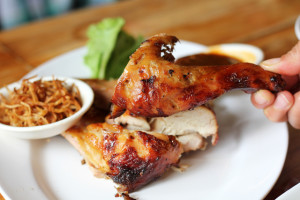 Other dishes to try include sai lua – lemongrass- and herb-scented sausages, and kai yaang – chicken stuffed with lemongrass, garlic, pepper and fresh coriander before being charcoal roasted and served with a tart tamarind dipping sauce. Adventurous eaters will also want to try yam samun phrai (a herb salad with a long list of fragrant ingredients – shredded betel leaf, basil, lime leaf, lemongrass, sawtooth herb and white turmeric mixed with peanuts, cashews, dried shrimp and chillies), and Isaan-style laap, which comes spiked with blood, offal and dried spices, giving it a slightly bitter edge.
Other dishes to try include sai lua – lemongrass- and herb-scented sausages, and kai yaang – chicken stuffed with lemongrass, garlic, pepper and fresh coriander before being charcoal roasted and served with a tart tamarind dipping sauce. Adventurous eaters will also want to try yam samun phrai (a herb salad with a long list of fragrant ingredients – shredded betel leaf, basil, lime leaf, lemongrass, sawtooth herb and white turmeric mixed with peanuts, cashews, dried shrimp and chillies), and Isaan-style laap, which comes spiked with blood, offal and dried spices, giving it a slightly bitter edge.
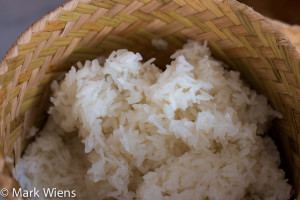 Sticky rice is the traditional starch of choice in northern Thailand. While plain sticky rice goes perfectly well with kai yaang or laap, sweet-toothed travellers will definitely want to try mango sticky rice while in Chiang Mai – head to Talat Ton Payom (Suthep Market) to try this, and the other dishes mentioned above.
Sticky rice is the traditional starch of choice in northern Thailand. While plain sticky rice goes perfectly well with kai yaang or laap, sweet-toothed travellers will definitely want to try mango sticky rice while in Chiang Mai – head to Talat Ton Payom (Suthep Market) to try this, and the other dishes mentioned above.
Where to stay?
All On the Road trips that pass through Chiang Mai stay at the beautiful Anantara Chiang Mai Resort. This sleek hotel is in a quiet but central location, where you can breakfast (and swim) overlooking the Mae Ping River. With a wonderful spa, and great restaurants and bars, the hotel is perfect for celebrating the end (or the start) of a fantastic journey – as is the rest of the city!
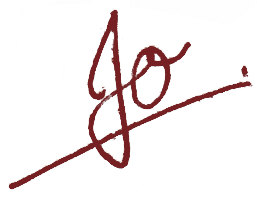
Explore Chiang Mai with these cross-border journeys…
From Shangri-La to the Lanna Kingdom
-
12 Day-journey
- Kunming – Shangri-La – Lijiang – Xizhou – Dianchi Lake – Xishuangbanna – Luang Namtha – Chiang Saen – Golden Triangle – Chiang Mai
- Travel Dates: Dec 22, 2017 – Jan 02, 2018
A BURMESE JOURNEY: From the Lanna Kingdom to the Bay of Bengal
- 12 or 17 Day-journey (Please note that while the full journey is 17 days, we also offer a shorter version. Please contact us for details.)
- Chiang Mai – Mae Sot – Hpa An – Taungoo – Inle Lake – Pindaya – Mandalay – Bagan – Magwe – Pyay – Ngapali
-
Travel Dates: Nov 3 – Nov 19, 2017 /Nov 24 – Dec 10, 2017/Jan 9 – Jan 25, 2018/Feb 8 – Feb 24, 2018
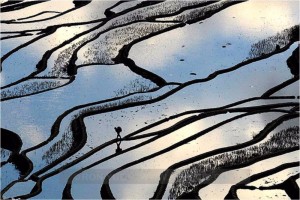 From Yunnan to the Lanna Kingdom
From Yunnan to the Lanna Kingdom
-
11 Day-journey
- Kunming – Yuanyang – Jiangcheng – Xishuangbanna – Luang Namtha – Chiang Saen – Golden Triangle – Chiang Mai
- Travel Dates: Nov 15-25, 2017
